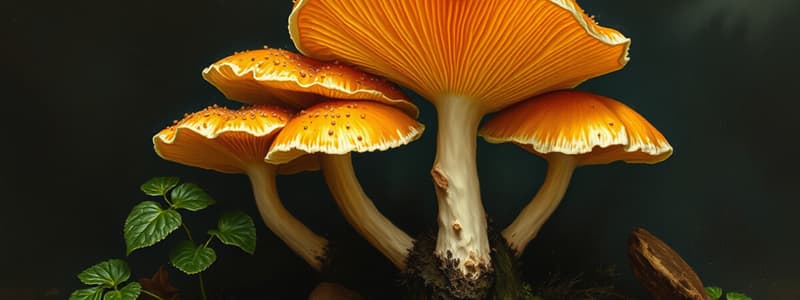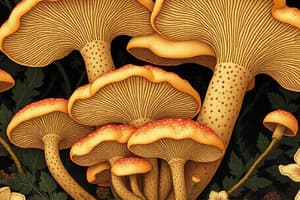Podcast
Questions and Answers
Which choice below generally represents the correct order of events in fungal sexual reproduction?
Which choice below generally represents the correct order of events in fungal sexual reproduction?
- Karyogamy, meiosis, plasmogamy, germination
- Plasmogamy, karyogamy, meiosis, germination (correct)
- Plasmogamy, meiosis, germination, karyogamy
- Germination, meiosis, karyogamy, plasmogamy
- Meiosis, plasmogamy, karyogamy, germination
Haustoria are specialized hyphae of __________.
Haustoria are specialized hyphae of __________.
both mutualistic and parasitic fungi
What is the major feature of glomeromycetes?
What is the major feature of glomeromycetes?
arbuscules
Multicellular fungal bodies are composed of __________.
Multicellular fungal bodies are composed of __________.
Fungal species are classified in a particular phylum based on __________.
Fungal species are classified in a particular phylum based on __________.
Two of the most common mycoses in humans are __________.
Two of the most common mycoses in humans are __________.
Molecular evidence suggests that fungi __________.
Molecular evidence suggests that fungi __________.
Hyphae with two nuclei per cell are called __________.
Hyphae with two nuclei per cell are called __________.
A parasitic fungus that attacks rye plants produces a structure called a(n) ________.
A parasitic fungus that attacks rye plants produces a structure called a(n) ________.
The __________ clade includes 160 species, with most producing arbuscular mycorrhizae.
The __________ clade includes 160 species, with most producing arbuscular mycorrhizae.
If your logic is correct, microscopic analysis of the tissue found in the stalk of this fungus will reveal the presence of __________.
If your logic is correct, microscopic analysis of the tissue found in the stalk of this fungus will reveal the presence of __________.
Fungi in the phylum Basidiomycota are the most important decomposers of wood because of their ability to break down __________.
Fungi in the phylum Basidiomycota are the most important decomposers of wood because of their ability to break down __________.
Fungi 'eat' their food by __________.
Fungi 'eat' their food by __________.
The decline of amphibian populations is most probably due to a(n) ________ parasite.
The decline of amphibian populations is most probably due to a(n) ________ parasite.
Ectomycorrhizal fungi __________.
Ectomycorrhizal fungi __________.
The zygosporangium __________.
The zygosporangium __________.
Flashcards are hidden until you start studying
Study Notes
Fungal Reproduction
- Fungal sexual reproduction sequence: Plasmogamy → Karyogamy → Meiosis → Germination.
- Karyogamy: Fusion of nuclei, occurs after plasmogamy.
- Meiosis: Produces spores after karyogamy.
- Germination: Process when spores develop into new fungi.
Specialized Hyphae
- Haustoria: Specialized hyphae found in both mutualistic and parasitic fungi, allowing nutrient exchange.
Glomeromycetes
- Key feature: Formation of arbuscules, structures that promote nutrient exchange in mycorrhizal relationships.
Fungal Structure
- Multicellular fungi: Composed primarily of filaments called hyphae, forming a network termed mycelium.
Fungal Classification
- Phylum classification: Based on the type of sexual structure they form, such as basidia, asci, or zygosporangia.
Common Mycoses
- Most prevalent human fungal infections: Athlete's foot and yeast infections, caused by specific fungal species.
Fungal Evolution
- Common ancestry: Molecular evidence supports that fungi and animals share a common ancestor, indicating a close evolutionary relationship.
Hyphal Structure
- Dikaryotic hyphae: Contain two nuclei per cell, a unique state in fungal development.
Parasitic Fungi
- Ergot: A structure produced by a parasitic fungus attacking rye plants, known for its harmful effects.
Glomeromycetes Clade
- Species abundance: Includes approximately 160 species, most recognized for forming arbuscular mycorrhizae with plant roots.
Basidiomycete Characteristics
- Fungal identification: Cells in the stalk of a basidiomycete such as a mushroom contain dikaryotic cells with haploid nuclei.
Wood Decomposition
- Basidiomycota role: Crucial decomposers of wood due to their ability to break down lignin, aiding in nutrient cycling.
Nutrient Absorption
- Feeding mechanism: Fungi digest food by secreting enzymes into the environment to break down organic matter, then absorbing smaller compounds.
Pathogenic Fungi
- Chytrid influence: Associated with the decline of amphibian populations, indicating a significant ecological impact.
Ectomycorrhizal Fungi
- Root interaction: Form sheaths of hyphae over plant roots and extracellular spaces, enhancing nutrient uptake in symbiotic relationships.
Zygosporangium
- Survival mechanism: Develops a thick-walled coating that can withstand harsh conditions for extended periods, crucial for fungal resilience.
Studying That Suits You
Use AI to generate personalized quizzes and flashcards to suit your learning preferences.




